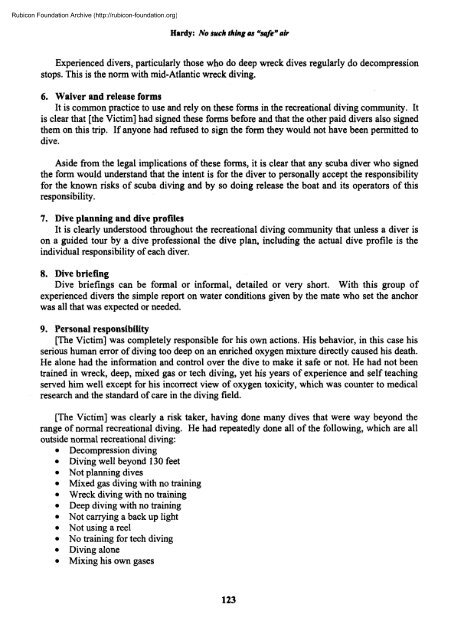Nitrox workshop dings - Divers Alert Network
Nitrox workshop dings - Divers Alert Network
Nitrox workshop dings - Divers Alert Network
You also want an ePaper? Increase the reach of your titles
YUMPU automatically turns print PDFs into web optimized ePapers that Google loves.
Rubicon Foundation Archive (http://rubicon-foundation.org)Hardy: No buck thing as "safe" airExperienced divers, particularly those who do deep wreck dives regularly do decompressionstops. This is the norm with mid-Atlantic wreck diving.6. Waiver and release formsIt is common practice to use and rely on these forms in the recreational diving community. Itis clear that [the Victim] had signed these forms before and that the other paid divers also signedthem on this trip. If anyone had refused to sign the form they would not have been permitted todive.Aside from the legal implications of these forms, it is clear that any scuba diver who signedthe form would understand that the intent is for the diver to personally accept the responsibilityfor the known risks of scuba diving and by so doing release the boat and its operators of thisresponsibility.7. Dive planning and dive profilesIt is clearly understood throughout the recreational diving community that unless a diver ison a guided tour by a dive professional the dive plan, including the actual dive profile is theindividual responsibility of each diver.8. Dive briefingDive briefings can be formal or informal, detailed or very short. With this group ofexperienced divers the simple report on water conditions given by the mate who set the anchorwas all that was expected or needed.9. Personal responsibility[The Victim] was completely responsible for his own actions. His behavior, in this case hisserious human error of diving too deep on an enriched oxygen mixture directly caused his death.He alone had the information and control over the dive to make it safe or not. He had not beentrained in wreck, deep, mixed gas or tech diving, yet his years of experience and self teachingserved him well except for his incorrect view of oxygen toxicity, which was counter to medicalresearch and the standard of care in the diving field.[The Victim] was clearly a risk taker, having done many dives that were way beyond therange of normal recreational diving. He had repeatedly done all of the following, which are alloutside normal recreational diving:• Decompression diving• Diving well beyond 130 feet• Not planning dives• Mixed gas diving with no training• Wreck diving with no training• Deep diving with no training• Not carrying a back up light• Not using a reel• No training for tech diving• Diving alone• Mixing his own gases123
















